As twilight envelops the sky, a mysterious phenomenon takes flight. V-formations of geese gracefully traverse the night, their honks piercing the darkness.
While we often associate migratory journeys with daylight, the nocturnal flights of geese have captivated the curiosity of many. Why do these majestic birds choose to embark on their long-distance travels under the veil of night?
In this blog post, we delve into the hidden motives behind geese’s nighttime migrations. Drawing from scientific research and folklore, we uncover the factors that drive geese to navigate the starlit expanse.
Join us as we unveil the secrets of why geese fly at night, unraveling the enigma behind their remarkable nocturnal journeys and gaining a deeper appreciation for the awe-inspiring wonders of nature.
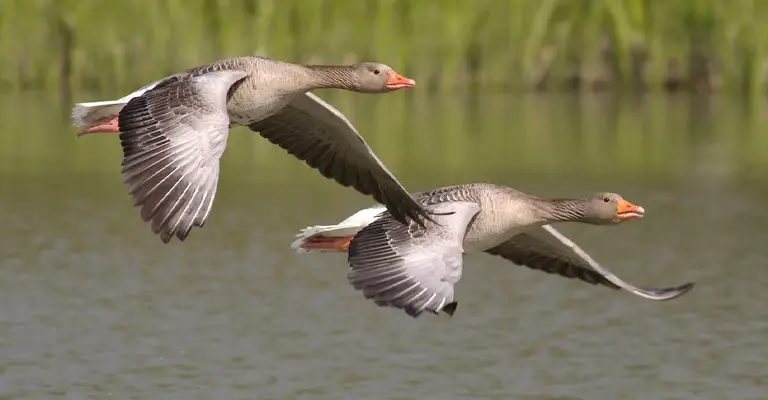
Calmer Air and Energy Conservation
Check out the following section as this unravels the factors of nighttime weather conditions and their impact on geese activity in the nighttime.
How Calmer Air at Night Reduces Energy Expenditure?
During the nighttime hours, the air tends to be more stable and less turbulent compared to daytime conditions. This means that geese encounter fewer obstacles and disturbances while flying.
Without the presence of thermal updrafts and the associated turbulence, geese can maintain a more consistent and efficient flight pattern.
As a result, they expend less energy to maintain stable flight, allowing them to conserve their limited energy reserves for the demanding journey ahead.
The Role of Thermal Updrafts and Turbulence During the Day
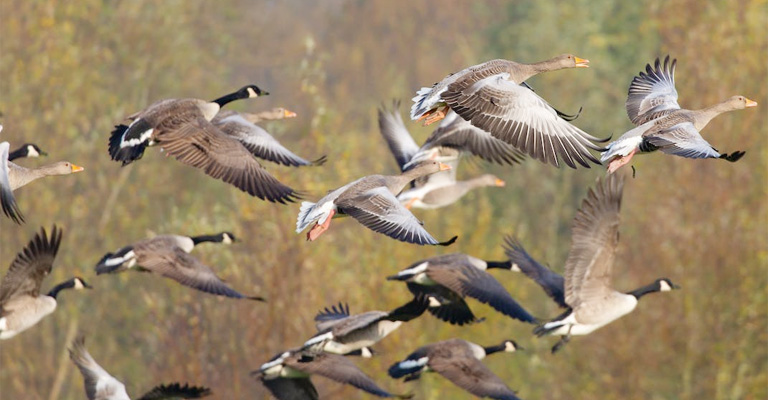
Daytime flights present different challenges for geese. The sun heats the Earth’s surface, causing air to rise and creating thermal updrafts. While these updrafts can provide a boost to flight performance, they are often accompanied by turbulence.
Turbulence requires geese to make constant adjustments to their flight path, resulting in increased energy expenditure.
Furthermore, turbulent air can make it harder to maintain a steady course and orientation, potentially leading to deviations from the intended migratory route.
Energy Conservation During Long-distance Flights
Long-distance migration is a physically demanding task for geese. They must travel thousands of kilometers, often across inhospitable terrains and adverse weather conditions.
Energy conservation is crucial for their survival and successful completion of the journey. By flying at night when the air is calmer, geese can minimize the energy they expend on flight control and stabilization.
This energy-saving strategy allows them to allocate their resources efficiently, ensuring they have enough energy for essential activities such as foraging and resting during stopovers along their migration route.
Geese choose to fly at night to take advantage of the calmer air conditions, reducing the energy expenditure required for flight control and stabilization.
Minimizing Predation Risk

There are some important facts on minimizing the risk of predators. So, try to understand the possible attitudes of Geese by reading this section below.
Highlighting the Diurnal Nature of Many Predators
Numerous predators, including birds of prey and other animals, are primarily active during the daytime. These diurnal predators rely on clear visibility and the advantage of daylight to hunt and locate their prey.
Geese, being well aware of this predator behavior, have adapted their migration patterns to minimize the risk of encounters with such predators.
By flying at night, geese can reduce their exposure to potential threats from diurnal predators, increasing their chances of survival.
Avoid Potential Threats During Daylight Hours
Daylight hours bring increased visibility, which benefits predators and poses a higher risk to migrating geese. By avoiding daylight hours, geese can minimize the probability of being detected or targeted by predators.
Flying at night provides a layer of protection, as the cover of darkness decreases the chances of being spotted by diurnal predators that rely on visual cues for hunting.
This reduces the likelihood of ambush or attacks during the critical migration period.
Flying at Night Enhances Geese’s Safety
Flying at night enhances the safety of geese during their migration in multiple ways. Firstly, it allows geese to exploit the element of surprise, as many predators are not actively hunting during the night.
By catching predators off guard, geese can evade potential threats more effectively. Additionally, the darkness provides a natural camouflage for geese, making it harder for predators to track their movements.
Geese, with their better night vision compared to humans, can navigate using moonlight and stars, maintaining their course while minimizing exposure to predators.
Geese flying at night strategically minimize their predation risk during migration. By avoiding encounters with diurnal predators, taking advantage of darkness, and capitalizing on their own night vision capabilities, geese enhance their safety and increase their chances of reaching their destination successfully.
The ability to adapt their flight patterns to avoid potential threats highlights the remarkable survival instincts of these migratory birds.
Moonlight Navigation
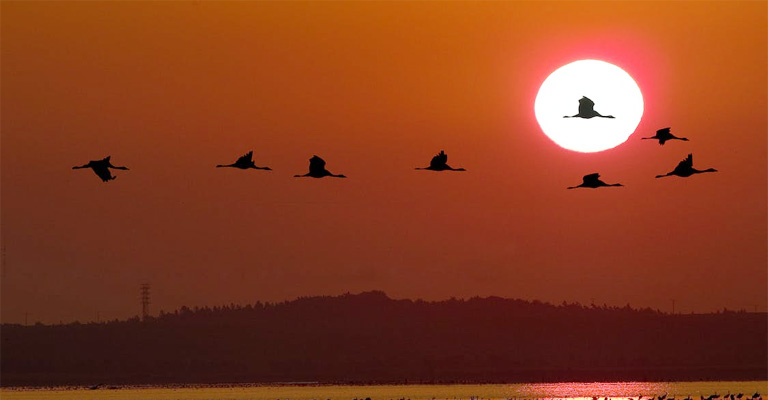
Navigation can play a big role in this nighttime venture of Geese. So, check out the following section to learn more about this matter.
Geese’s Ability to Navigate Using the Moon and Stars
Geese possess a remarkable instinct for celestial navigation. They can detect and interpret subtle changes in the positions of celestial objects, such as the moon and stars, to orient themselves during their flights.
By using the night sky as a reference point, geese are able to establish their general direction and maintain a course that aligns with their intended migration route.
This celestial navigation ability is believed to be an innate skill passed down through generations of migratory geese.
Use Moonlit Nights for Navigation
Moonlit nights offer a surprising amount of illumination for geese to navigate effectively. Even without the presence of artificial lighting, the moon provides a natural source of light that allows geese to see their surroundings to a reasonable extent.
The moon’s reflected light illuminates the landscape below, offering enough visibility for geese to distinguish features and landmarks that aid in navigation.
Although their night vision may not be as sharp as during the day, geese’s adaptations enable them to utilize the available moonlight for successful navigation.
Maintaining Course and Orientation During Migration
Maintaining the correct course and orientation is vital for geese during their migration. Deviations from their intended path can result in significant detours, wasted energy, and potential risks.
Geese rely on the consistency of celestial cues to stay on track. By continuously monitoring the positions of the moon and stars, they can make necessary adjustments to ensure they are heading in the right direction.
This unwavering commitment to maintaining course and orientation allows geese to navigate accurately and reach their destination efficiently.
Geese’s ability to navigate using the moon and stars is a remarkable adaptation for their migratory journeys.
By utilizing the night sky as a navigational tool, geese can establish their direction, take advantage of moonlit nights for visibility, and maintain a steady course toward their destination.
The precision and reliability of their celestial navigation skills highlight the incredible instincts and adaptability of these migratory birds.
Cooler Temperatures and Flight Performance
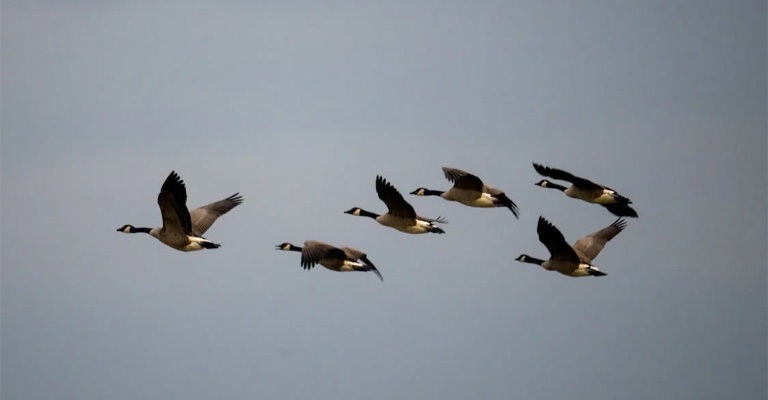
Nighttime temperatures are generally cooler compared to the heat of the day. This has a significant impact on geese’s heat stress and thermoregulation.
During the flight, geese generate metabolic heat, and excessive heat accumulation can be detrimental. Cooler temperatures alleviate the risk of overheating, as the temperature differential between the environment and their bodies is reduced.
This allows geese to maintain a more comfortable body temperature and regulate their metabolic processes more efficiently during their demanding migratory flights.
Effect of Cooler Temperatures on Flight
Cooler temperatures are associated with lower air density. Air density affects the aerodynamic performance of geese during flight. As the density decreases, the air becomes thinner, reducing drag and resistance against the bird’s wings.
This results in improved flight efficiency and reduced effort required to maintain optimal airspeed. Geese can glide through the air with less resistance, conserving energy and making their flight more economical.
Contribution of Temperatures to Enhanced Flight Performance
Reduced heat stress and improved aerodynamic performance due to cooler temperatures directly contribute to reduced effort and enhanced flight performance for geese.
By minimizing the energy expended on thermoregulation, geese can allocate more resources to other vital activities, such as foraging and rest during stopovers.
The decreased drag and improved glide ratio resulting from lower air density allow geese to maintain their desired airspeed with less wing flapping, conserving energy and enabling them to cover longer distances more efficiently.
Cooler temperatures have a positive impact on geese’s flight performance during migration. They alleviate heat stress, enhance thermoregulation, reduce drag, and improve aerodynamic efficiency.
These factors collectively contribute to reduced effort and enhanced flight performance, allowing geese to optimize their energy utilization and successfully complete their long-distance journeys.
The adaptation to take advantage of cooler temperatures showcases the remarkable physiological and behavioral adaptations of these migratory birds.
Daytime Flight Strategies
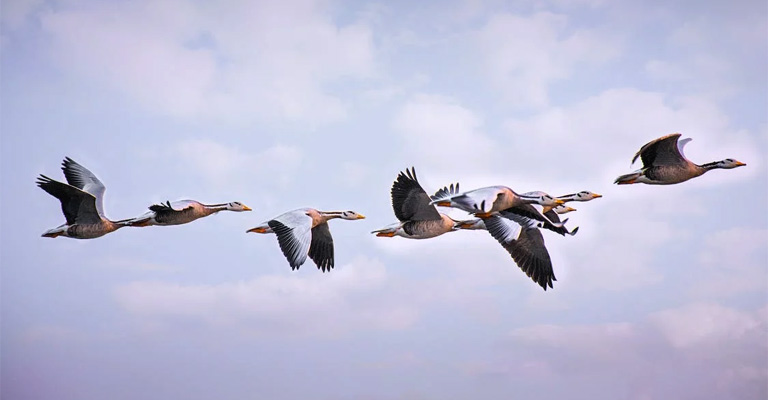
There are some points under daytime flight strategies of Geese that are strongly needed to be put lights on. Check them out in the following phase.
Geese Also Fly During the Day in Certain Conditions
It is important to note that geese do not exclusively fly at night during migration. In certain situations, they engage in daytime flights. This is particularly true when favorable conditions arise that can aid their journey.
Geese adapt their flight patterns based on various factors, including weather, wind patterns, and the availability of resources. Their flexibility allows them to optimize their flights and increase their chances of reaching their destination successfully.
Taking Advantage of Helpful Tailwinds and Updrafts
During the day, geese benefit from favorable wind conditions, such as tailwinds. Tailwinds provide a boost to their flight by propelling them forward, reducing the energy required to maintain their desired airspeed.
Moreover, geese take advantage of updrafts, which are rising columns of air caused by thermal activity or wind patterns. Updrafts can provide geese with a natural lift, allowing them to soar and conserve energy by minimizing wing flapping.
By strategically utilizing tailwinds and updrafts, geese can maximize their efficiency and cover greater distances during their daytime flights.
Avoiding Headwinds and Unfavorable Weather Conditions
Geese exhibit a remarkable ability to sense and avoid headwinds and unfavorable weather conditions. Headwinds pose a significant challenge for flight, as they create resistance and increase the effort required to maintain forward motion.
Geese have the instinct to avoid flying into headwinds, which would impede their progress and expend additional energy. They often alter their flight routes or wait for more favorable wind conditions before resuming their journey.
To add, geese are adept at detecting and avoiding unfavorable weather conditions, such as storms or severe turbulence, which could pose a risk to their safety and flight stability.
Flight Strategies of Geese During Migration
| Flight Strategy | Description |
| Nighttime flights | Steering clear of winds blowing in the opposite direction, reduces resistance and energy expenditure. |
| Daytime flights | Flying during the day under favorable conditions, taking advantage of tailwinds and updrafts. |
| Utilizing tailwinds | Harnessing favorable winds blowing in the same direction to enhance flight efficiency. |
| Capitalizing on updrafts | Utilizing rising columns of air, such as thermal updrafts, to soar and conserve energy. |
| Avoiding headwinds | Steering clear of winds blowing in the opposite direction reduces resistance and energy expenditure. |
| Adaptation to weather | Sensing and avoiding unfavorable weather conditions, such as storms or turbulence. |
FAQs
No, not all species of geese migrate. While many species of geese undertake long-distance migrations, some populations of geese are non-migratory, remaining in their breeding or wintering grounds throughout the year.
The distance of goose migration varies depending on the species and the specific population. Some geese can travel thousands of kilometers during migration, while others may have shorter migration routes.
For example, the Arctic Tern, a type of bird that is closely related to geese, holds the record for the longest migration, covering over 70,000 kilometers round trip.
Geese have an innate sense of direction that helps them navigate during migration. They rely on a combination of celestial cues, such as the sun, moon, and stars, as well as landmarks, geographic features, and even Earth’s magnetic field to orient themselves and determine the correct migratory route.
Yes, geese can adjust their migration route based on various factors. They have the ability to assess environmental conditions, such as wind patterns and food availability, and make course corrections accordingly.
This adaptability allows geese to optimize their migration and respond to changes in their habitat.
Yes, migration poses several risks for geese. Predation is a significant concern, as migrating geese may encounter predators such as birds of prey along their journey.
Moreover, unfavorable weather conditions, including storms and strong headwinds, can pose challenges and increase energy expenditure for geese during flight.
Conclusion
The phenomenon of geese flying at night is driven by a combination of factors that enable their survival and navigation.
Geese are known to be migratory birds, and flying at night offers several advantages, including cooler temperatures, reduced predation risks, and clearer skies for navigation by stars and landmarks.
Furthermore, flying during the night allows geese to avoid competing for airspace with other diurnal birds. By harnessing their remarkable abilities and utilizing the cover of darkness, geese exemplify nature’s adaptive strategies for successful long-distance migration.
Please share your thought with us after reading this helpful article.